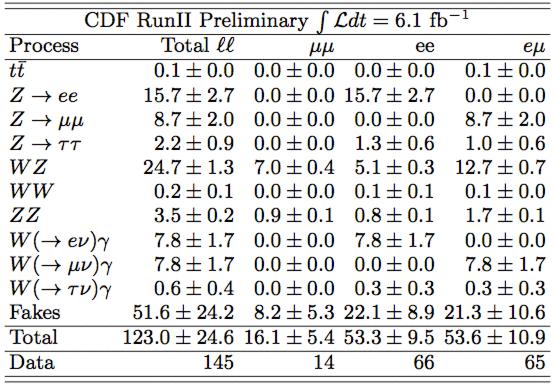The table below has been produced in a CDF search for events containing same-sign lepton pairs: a striking signature of new physics, faked by very few processes. Because of the paucity of Standard Model sources, even relatively small new physics signals can emerge in such a sample. The CDF analysis is based on 6.1 inverse femtobarns of proton-antiproton collisions collected at the Tevatron during Run II. Let us see what the table tells us.

First of all, there are four columns. The first shows the total yield of events, the other three detail the number of events in three disjoint subclasses: events with two electrons, two muons, or an electron and a muon. Backgrounds contribute differently to these three signatures.
Each row shows a different background process, and its expected yield in each of the classes. Let us examine the most important of these.
The first column shows the prediction for top-antitop production: can it produce high-energy, isolated leptons of the same charge ? No, as is evident. The two W bosons emitted in the decay of the top-antitop pair have opposite charge of course; only in case a b-quark decays semileptonically and the resulting electron or muon takes away almost all of the b-quark energy, can one get a same-sign dilepton topology from ttbar; but this is essentially a negligible contribution, once analysis cuts are applied.
Instead, we see that Z decays can produce a significant yield, but only in the dielectron category. Why not dimuons ? Because electrons readily radiate energetic photons, while muons do so much, much less frequently (the probability of photon emission by bremsstrahlung is inversely proportional to the fourth power of the particle mass). Now, if an electron radiates a energetic photon, and the photon converts into an electron-positron pair, then what we might end up observing is a energetic positron from the original electron! So the Z yields occasionally two positrons of high energy, plus less energetic electrons that do not get detected. That is the origin of those 15.7 events in the Z->ee row, which are also known as "tridents" because of the topology of the radiation.
Another important physics background comes from WZ pairs. Of course, if the Z decays to dileptons and the W also decays to a lepton-neutrino pair, and if we only detect two of the three energetic leptons, we may end up seeing two same-sign leptons.
Interesting are also the predicted yields of radiative W decays, i.e. ones producing, together with a lepton pair (electron-neutrino, or muon-neutrino) a energetic photon. The photon can be mistaken for an electron sometimes, so the resulting signature is either a e-mu or a e-e category, but of course no mu-mu category. The yield is roughly the same in the two cases, since the amount of W decays to electron-neutrino and to muon-neutrino pairs is the same.
Finally, the main contribution comes from fakes: leptons that are not leptons. These signatures occur when a jet fragments in a leading electron or muon (for example by a semileptonic heavy flavour decay). Note that electrons are more readily faked than muons, as is clear by the relative population of the three subclasses.
All in all, backgrounds are well under control: the observed yields (last row) appear consistent, if slightly in excess, with the total prediction. No new physics!
The paper describing in detail this search is available here.



Comments